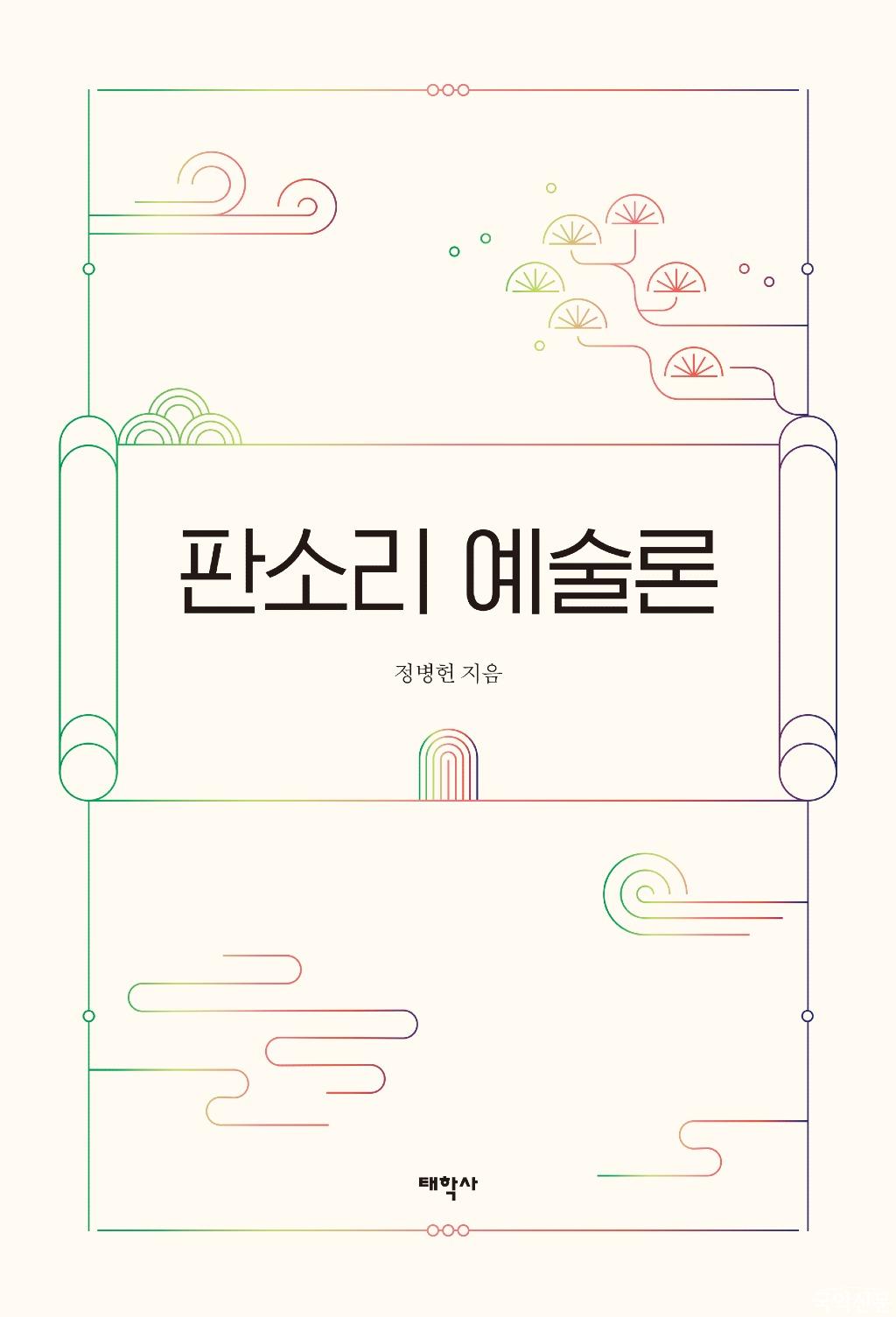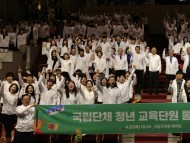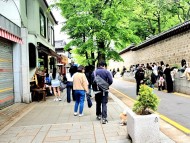2024.05.02 (목)
[The Book That I Read] Art Theory of Pansori
- Reporter intern…
- 등록 2022.07.23 19:35
- 조회수 995

Art Theory of Pansori(판소리 예술론) is written by Byeong-Heon Jeong and was released in September of 2021 by the publishing company Taehaksa. Jeong received his Ph.D. from Seoul University and taught as a professor at Chonnam National University and Sookmyung Women's University. Other books he has written includ 'A Study of Shin Jaehyo's Pansori Editorial'(신재효 판소리 사설의 연구), 'Culture Theory of Pansori' (판소리 문학론),'Pansori and South Korea's Culture'(판소리와 한국 문화),'Pansori and People'(판소리와 사람들), and 'Lyrics by Shin Jae-Hyo'(신재효의 가사) which shows his extended knowledge of pansori.
In Art Theory of Pansori, Jeong uses five diverse chapters to explain his idea of pansori's art theory. Every chapter zooms in on a specific aspect of pansori. The first chapter reveals Jeong's general thoughts about the formation of pansori, in which he mostly focuses on how pansori was able to establish itself as a genre as it changed through human contact. In his second chapter, he explores Shin Jae-Hyo and Jeong Hyeon-Seok's writings on pansori, who are two important figures in pansori.
In chapter 3, the principle of laughing as a characteristic of pansori is brought to light. Jeong prefaces this chapter by saying his chapter needs further research, but he gives a very detailed overview of the parts in Jeokbyeokga that are supposed to make audiences laugh. In chapter 4, Jeong tries to find the reason why 7 of the 12 pansori works have disappeared. He specifically contests the idea that the noble class or the quality of the other pansori pieces are to blame for their disappearance. Finally, his last chapter addresses different arts that have derived from pansori. Pansori novels, changgeuk, and North Korean operas all started as pansori but their styles have changed as time went on.
As one might expect from reading the title, this book focuses on a lot of details that encompass the genre of pansori. Not only does it concentrate on very specific moments in each pansori epic story, but it also makes use of a lot of jargon that those unfamiliar with pansori might not immediately understand. It is thus advised to read this book with sufficient knowledge of the five pansori epic stories and at least a basic understanding of pansori theory.
I chose to read this book because of my interest in pansori and I thought a book on the theory of pansori might help me in my understanding of the genre. Even if the theory used in the book was sometimes difficult to follow, I enjoyed reading Art Theory of Pansori and feel like I have learned a lot. As the author discusses quite some issues that I had never considered while studying pansori, I was able to make a lot of notes.
Jeong manages to effectively address issues in pansori studies that I personally have not encountered as of yet, which enabled me to take an interest in many parts of the book. His engagement with Jeokbyeokga is especially interesting as I have not come across many studies of this epic and it is therefore also the epic I am least familiar with. I also very much enjoyed his theory on the creation of pansori, in which he insinuates that it is not Honam where pansori started, but it was Honam where other artists spread over the entire country came together to set a standard for pansori. As I have a passion for the divide between fusion-style pansori and standard pansori, I liked chapter 5 in particular. When Jeong presented different artforms that hold their origins in pansori, his ideas and theories on the conflict between relying on pansori or embracing a new art style that some new artforms go through were a pleasure to read and helped me gain new perspectives on fusion art.
- [] 제6회 울진금강송 전국국악경연대회(06/08)
- [] 제29회 대통령상 한밭국악전국대회(07/06-07) (무용/기악/성악)
- [] 제8회 목담 최승희 전국국악경연대회(06/01) (판소리,기악)
- [] [서울]제28회 전국판소리경연대회(06/15-16)
- [] 제32회 대전전국국악경연대회(06/01-02)
- [] 제16회 순천 낙안읍성 전국가야금병창경연대회(05/25-26)
- [] 제18회증평국악경연대회(05/11)
- [] [군산]제32회 전국청소년민속예술경연대회(05/18)
- [] 제42회 전주대사습놀이 학생전국대회(5/18∼6/2)
- [] 제50회 전주대사습놀이 전국대회(5/18~6/3)
- [] 제20회 전국대금경연대회(06/08-09)
- [] 제4회 함양 전국국악경연대회(05/12)
- [] 제18회 대한민국 전통예술무용·연희대제전(06/09)<br>무용(전통무용…
- [] 제48회 부산동래 전국전통예술경연대회(06/15-16)(무용.기악)
- [] [부여]제1회충남전국청소년국악경연대회(05/04)(판소리.기악.타악)
- [] [광주]제21회 대한민국 가야금병창대제전(06/16)
- [] 제18회 과천전국경기소리경창대회(05/04)
- [] 제11회 곡성 통일전국종합예술대전(06/15-16)(판소리.무용, 기악,…
- [] 제24회 인천국악대제전 전국국악경연대회(05/25-26)
- [] 제26회 창원야철전국국악대전(07/06- 07)
- [] 2024 무안장애인 승달국악대제전(06/01-02)
- [] 제22회 무안전국승달국악대제전(06/01-02)
- [] 제10회 전국공주아리랑민요경창대회(05/26)
- [] 제17회 상주전국국악경연대회(05/19)(성악/무용·연희/기악)
- [] 제10회 전국밀양아리랑경창대회(05/26)
- [] 제21회 강남전국국악경연대회(05/22)(무용/타악/판소리/민요)
- [] 제26회 서편제보성소리축제 전국판소리 고수 경연대회(05/04-05)
- [] [순천]제10회 낙안읍성 전국 국악대전(04/27-28)
- [] 제29회 안산전국청소년국악경연대회(05/26)
- [] 제26회(통합58회) 여수진남전국국악경연대회(05/18-19)
- [] 제51회 대한민국 춘향국악대전 경연대회(05/05)(05/11-12)
- [] 제33회 고령전국우륵가야금경연대회(04/26-27)
- [] [부평]제8회 전국 청소년국악경연대회(05/11)(관악/현악/성악)
- [] 제22회 구례전국가야금경연대회(05/04-05)
- [완도]제24회 장보고국악대전 전국경연대회(05/05-06)(무용/판소리…
- [] 제23회 대한민국 빛고을 기악대제전(05/25-26)
- [] [인천] 제10회 계양산국악제(04/26-27) (풍물,사물, 기악,민요…
-

[국악신문] 정창관의 ‘국악-신반’ <21>
윤하림 해금풍류 II 산조 윤하림 해금풍류 II 산조. (2024년 Sound Press 음반번호없음) 2023년 윤하림 ...
-

[국악신문 소장자료] (42)아리랑 최초 취입 아리랑, ‘1913년 京城卵卵打令’
일본 니포노폰 취입 조선민요 ‘경성란란타령’, 1913년 Nipponophone 6170 SP음반.(국악신문 소장자료) ...
-

[금요연재] 도자의 여로 (142)<br>분청철화어문병편
쏘가리 문양 도편 한 점 없이 이규진(편고재 주인) 계룡산 하면 무엇이 떠오를까. 조선 왕도로서의 도읍지를 생각한다면 무학대사를, 민속신앙의 터전을 염두에 둔다면 신도...
-

[국악신문 소장자료] (41)’무궁화노래‘가 처음 불려진 독립관(獨立館) 전경
1897년 8월 13일 ‘대조선 개국 505회 기원절 경축식’에서 계관시인 윤치호가 작사한 무궁화노래(찬미가 제10장)가 처음 발표된 독립관 전경. 현 애국가의 원형 ‘...
-

세실풍류, 박병천의 '구음시나위'에 허튼춤 선사한 안덕기
국립정동극장이 4월 한달간 진행하는 '세실풍류 : 법고창신, 근현대춤 100년의 여정'에서 23일 박병천의 '구음시나위'에 허튼춤 추는 안덕기 (사진=국립정...
-

세실풍류, 동해별신굿 민속춤사위를 제해석한 조재혁의 '현~'
국립정동극장이 4월 한달간 진행하는 '세실풍류 : 법고창신, 근현대춤 100년의 여정' 에서 조재혁의 '현~' 공연 모습. (사진=국립정동극장). 2024....
-

[Pick리뷰] 이호연의 경기소리 숨, ‘절창 정선아리랑!’
# ‘이호연의 경기소리 숨’ 공연이 지난 4월 26일 삼성동 민속극장 ‘풍류’에서 열렸다. 20대에서 60대까지의 제자들 20명과 5명의 반주자와 함께 경기잡가, 경기민요, 강원도...
-

[PICK인터뷰] 미리 만나 보는 '제94회 남원춘향대전'
[국악신문 정수현 전문기자]=대한민국에서 가장 오래된 축제로 손꼽히는 남원춘향대전(남원춘향제)이 오는 5월 10일(금)부터 5월 16일(목)까지 7일간 남원시 광한루원 일대에서 열...
-

[Pick리뷰] 모던연희극 ‘新칠우쟁론기’
4월 18일부터 20일, 남산국악당에서 아트플랫폼 동화의 모던연희극 ‘新칠우쟁론기’가 펼쳐졌다. [국악신문 정수현 전문기자]=지...
-

[PICK인터뷰] 국립국악관현악단의 채치성 예술감독을 만나다
[국악신문 정수현 전문기자]=봄비가 촉촉이 땅을 적시는 4월, 국립국악관현악단 예술감독으로 취임한 지 6개월이 된 채치성 예술감독님을 만났다. 그는 국악방송 사장, KBS 국악관현...
-

[Pick리뷰] 이 시대의 새로운 춘향가- ‘틂:Lost&Found’
2024 쿼드초이스_틂 (사진=서울문화재단 대학로극장 쿼드 나승열) [국악신문 정수현 전문기자]=대학로극장 쿼드의 ‘쿼드초이스’...
-

[Pick리뷰] 세 악단의 조화로운 하모니, ‘하나 되어’
지난 4일, 국립국악원은 국립국악원 창작악단, KBS국악관현악단, 전북특별자치도립국악원 관현악단 118명으로 구성된 연합 관현악단 무대 ‘하나되어’를 국...
-

[인터뷰] 김경혜의 '시간의 얼굴' 작품전, 16일 개막
칠순을 넘어서는 길목에서 중견작가 김경혜(영남이공대 명예교수) 작가의 열번째 작품전이 오는 16일부터 25일까지 10일간 대구시 중구 슈바빙 갤러리에서 열린다.전시되는총 50여 개...
-

[Pick리뷰] 국립국악관현악단의 관현악시리즈 III ‘한국의 숨결’
국립국악관현악단의 관현악시리즈 III ‘한국의 숨결’이 KBS국악관현악단 상임지휘자 박상후의 지휘로 국립극장 해오름극장에서 펼쳐졌다. (사진=국립국악관현악단...






























